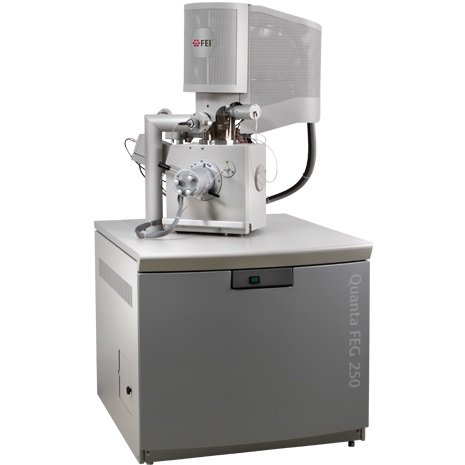
ENVIRONMENTAL SCANNING ELECTRON MICROSCOPE: SEM-QUANTA FEG-250 (ESEM)
The Quanta FEG-250 SEM instrument is an environmental Scanning Electron Microscope used for high-resolution imaging and composition analysis by energy-dispersive X-ray microanalysis (EDS).
The FEG column in Quanta 250 allows beam deceleration, which permits to achieve a resolution of 1.4 nm even at 1 kV electron landing voltage. The Quanta equipment can work under three different pressure ranges, the maximum pressure being 2600 Pa. This permits observation of life-sciences samples without previous metallic coating, i.e., studies in environmental conditions (ESEM).
This microscope allows the use of a Wet-STEM, which permits to analyze samples with controlled humidity and temperature, which is crucial in life-science samples. The SEM-Quanta can also use a heater to perform observations on samples heated up to 1000 ºC and detect changes in the morphology of the material. In addition, with this microscope de-acceleration of the electron beam over non-conductive samples can be performed leading to 1.4 nm resolution even at 1 kV.
What can be done with it?
Image / Analysis
- By using the different SEM Detectors with which this instrument is equipped, the following information can be obtained:
- Image with secondary electrons-Topography: using an ETD/FLD (Everhart-Thornley Detector/ Large Field) detector for secondary electrons.
- Image (back scattered electrons) and composition by using GAD/vCD (Gaseous Analytical Detector/Low voltage High Contrast) detector.
- Images with secondary electrons from the gas phase by using a GSED/GAD (Gaseous Secondary Electron Detector/Gaseous Analytical) detector, for secondary electrons from the gas phase.
- Elemental chemical analysis by means of Energy-dispersive X-ray spectroscopy (EDX).
- STEM (scanning-transmission) Images by using a Scanning Transmission Electron Microscopy detector.
In situ experiments
- Heatting stage: annealing of the sample up to 1000 ºC with observation using a secondary electron detector.
- Peltier stage: changes in pressure, temperature and relative humidity of the chamber observing the sample using secondary electron or back-scattered electron detectors.
- Wet-STEM y STEM: Scanning Transmission Electron Microscopy in wet mode and also at high vacuum with dried samples.
Sample requirements:
Liquid and non-conductive samples observed at high vacuum mode need to be dried and metallized prior to observation. Samples studied at low vacuum or ESEM modes do not require any previous preparation.
Types of samples that can be studied with SEM-Quanta FEG-250 include:
- Bulk materials, films, coatings, and compacted powders either conductive or non-conductive can be studied.
- Samples compatible with high vacuum, low vacuum and ESEM mode conditions.
- Wet samples.
- Sample can have a diameter from less than 1 mm up to 5 cm for high and low vacuum. ESEM (environmental SEM) observations require small samples (5 mm).
Especificaciones técnicas:
- SEM
- 1 kV / 3.0 nm
- 30 kV / 1.0 nm
- 3 kV (low vacuum) / 3.0 nm
- Maximum beam current: 200 nA
- VACUUM (modes)
- High & Low (low, up to 200 Pa)
- ESEM (2600 Pa)
- STAGE
- X x Y x Z (mm) / 50x50x50mm
- DETECTION
- Solid state BSE / BSED, vCD, DBS
- STEM / STEM
- Low vacuum / LFD, GAD
- ESEM™ / GSED, GBSD, ESEM-GAD
- IMAGING
- Scan strategies / FEI Smartscan™, DCFI
- CLEANLINESS
- CryoCleanerEC, Integrated Plasma Cleaner
- NAVIGATION & LARGE IMAGES
- MAPS, Nav-Cam
- CHAMBER
- Large chamber, 10 ports




